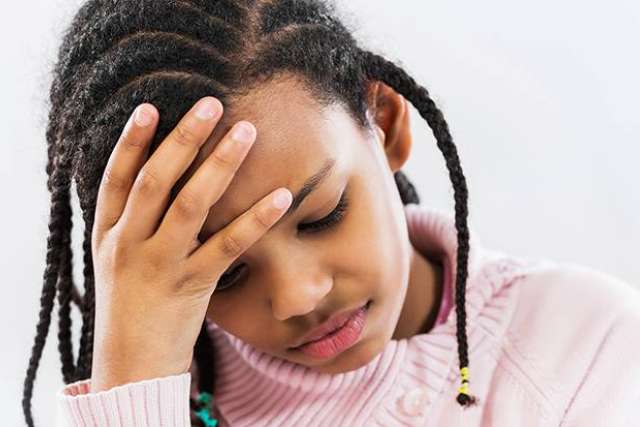
Headaches are one of the most common complaints in children and adolescents. By age 18, 90 percent of kids have experienced a headache. Before age 12, the incidence of headaches is equal among boys and girls. But after age 12, headaches are more common in girls.
What Causes Headaches in Kids?
There are two types of headache, characterized by what causes them:
Primary headache
A primary headache occurs when something inside the brain causes the headache. Types of primary headache include:
- Migraine headache
- Tension headache
- Cluster headache
Secondary headache
A secondary headache occurs when something acts on the brain to cause the headache. Causes of secondary headache include:
- Cold, flu or sinusitis
- Trauma to the head
- Medication side effects or overuse
- Brain tumor
Kinds of Headache in Children
While headache symptoms in children aren’t always “classic,” these are what to look for:
Migraine headache
A migraine headache is the most common type of headache in children and teens. It causes moderate-to-severe pain that:
- Lasts 2 to 72 hours if not treated
- Occurs on one side of the head
- Throbs
- Worsens with activity
- Causes nausea or vomiting
- Occurs with light or sound sensitivity
- Comes with an aura (visual or sensory disturbance) in 10 percent of kids
Tension headache
A tension headache is the second most common type of headache in youth. It causes mild-to-moderate pain that:
- Covers the entire head (diffuse)
- Doesn’t throb
- Doesn’t worsen with activity (though the child may not feel like being active)
Cluster headache
Cluster headaches are very rare in children, they cause a sharp pain that:
- Occurs on one side of the head, usually in the face
- Comes with tearing eyes or a runny nose
- May result in one pupil being a different size than the other
- May cause an eyelid to droop
Treatments for Childhood Headaches
Using over-the-counter (OTC) medications is often all that is needed to treat secondary headaches in children. You may have limited success using OTC meds to treat primary headaches. It is important not to overuse pain relievers for more than two days per week since overuse can actually cause headaches. Other pain relief options include:
Migraine pain relief
The OTC drugs ibuprofen and naproxen sodium are more effective than acetaminophen at reducing migraine-associated pain. Some prescription triptan medications can be used safely, and there is a prescription nasal spray approved to treat migraines in children.
It is also important to try and prevent migraines. Experts recommend keeping a calendar or headache diary to record when headaches occur and what may trigger them. For example:
- Poor quality sleep may be prevented by emphasizing good sleep hygiene.
- Menstruation-related migraines can be prevented by taking naproxen 1 to 2 days before the expected onset of a period-related headache, and for the duration of menstruation.
- Anxiety may be managed with behavioral treatments like cognitive behavioral therapy, biofeedback or relaxation exercises.
Other general prevention tips for migraines include:
- Routinely eating meals
- Regular exercise
- Adequate intake of fluid
- Supplements like magnesium and riboflavin
- Preventive prescription medications like topiramate or amitriptyline taken 1 to 2 times per week
Tension headache pain relief
As with a migraine, reach for ibuprofen and naproxen sodium rather than acetaminophen to reduce headache pain.
Preventing tension headaches with prescription medicines may not be as effective, though your child’s provider may try them if the potential benefit outweighs the risk. Another prevention approach is teaching methods to alleviate stress and anxiety, including biofeedback and relaxation exercises.
When your child experiences a tension headache, they may get relief by:
- Relaxing or laying down
- Having a cool wet cloth on their forehead
- Stretching their neck and shoulder muscles, or having a caregiver offer gentle massage
- Eating a snack
- Taking in more fluid so they don’t become dehydrated
When to Worry About Headaches in Children
If your child tells you they have the worst headache of their life, seek care urgently. While unlikely, they could be experiencing a brain hemorrhage. Other signs that your child needs to see a provider for a headache evaluation include:
- Pain that consistently wakes your child from sleep or causes them to miss school
- Early morning vomiting without nausea
- Headache pain that is different from before, is worsening or is occurring 3 to 4 times a month
- A fever or stiff neck
- Personality changes
- A headache that begins after an injury
If your child experiences frequent headaches, talk to their pediatrician for support and advice. If you need a pediatrician, contact the UCLA Division of General Pediatrics or request an appointment by calling 310-825-0867.



